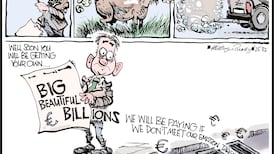GHOST ESTATES are a recent phenomenon. Housing developments lie empty throughout the country, thanks to the magical disappearing act of the Celtic Tiger. Being a recent Irish phenomenon, it has taken a little time for Irish language wordsmiths to come up with a translation.
“Eastáit na Si” or “Fairy Estates” is, of course, open to misinterpretation in today’s sexually-oriented parlance, but is an elegant Gaelicisation of this modern landmark feature and can be linked to the longstanding regard in which the Irish have held the “little people” or those from an “domhan eile”.
Traditionally, fairy forts have been respected lest the disturber would incur the wrath of the fairy folk, accounts of which feature in Sinéad de Valera’s much loved books of fairy tales.
The problem of an Irish language translation for the term ghost estates hasn’t been vexing our political rulers too much of late, however, as they have been grappling with the question of what will happen these vacant hamlets if they lie unoccupied for too long.
There may be a magical solution to the phenomenon of ghost estates/eastáit na sí which would result in the almost instantaneous occupation of these homes by Irish-speaking families.
My proposal is to designate a number of these estates as new Gaeltachtaí. There hasn’t been a new Gaeltacht, officially, since 1956, when the current boundaries for the Irish- speaking areas were set in legislation by Patrick Lindsay, the then Minister for the Gaeltacht.
There have been other attempts to establish Gaeltachtaí by dedicated communities in Cork and Belfast and these have had spectacular success with a significant benefit to society as a whole – though they haven’t received official recognition.
In Belfast, the Shaws Road Gaeltacht led to a renaissance in the Irish language in west Belfast, a revival which in turn generated a resurgence in the economy and confidence in that quarter of the city.
The new “Gaeltacht” in Cork, Ard Barra, led to the establishment of Coláiste an Phiarsaigh and Scoil na nÓg and the success of these schools prompted the establishment of several more Gaelscoileanna on the banks of the Lee.
It’s as if the Irish language in the hands of those who love it and use it daily, and not in the dead hand of Government bureaucrats, had spread a magic dust which turned all it touched to gold.
Official efforts to revive Irish such as the Official Languages Act have had the effect of increasing bureaucracy without any visible benefit to the use of Irish among the people.
The banishment of the Celtic Tiger has led to the emergence of this new opportunity. The growth of Gaelscoileanna – there’s at least one in every county in Ireland now – throughout Ireland is an indication that should there be a way of dealing with the red tape, the families to turn these empty shells into happy homes are there. Whereas before it was prohibitively expensive, now it’s affordable.
As the Government is shortly to assume ownership of these estates, is it too much to ask that it might make them available for this and other uses of possible social benefit rather than plough them into the ground? Already a group has been established in Dublin, under the auspices of the Irish language organisation, Comhluadar, to explore the possibilities of establishing a new Gaeltacht in the capital.
AN ADDITIONAL area of growth for the Irish-speaking community has been the online Gaeltacht which is different type of "other worldly" Gaeltacht. "Gaeltacht ár linne, Gaeltacht ar líne/The Gaeltacht of our time is the Gaeltacht Online" is the motto of this new movement and its growth is rapid as increasingly Irish speakers connect with each other using platforms such as Facebook, Twitter and the blogosphere. All this Irish language activity online goes under the term "Gaeltacht 2.0".
This St Patrick’s Day will be the second ever #lnag – netspeak for Lá na Gaeilge – and Irish speakers at all levels of ability are being encouraged to use their Irish on the web on that day. All we’re being asked to do is to include “#lnag” in the text of our communication to ensure it’s transmitted, tweeted and re-tweeted throughout the web.
The virtual Gaeltacht 2.0 and the vision of Gaeltacht of “Eastát na Sí” complement one another perfectly as the online Gaeltacht provides the tools to draw together those people who have the interest and the drive to set about this new challenge.
Neither of these is dependent on grant-aid to thrive – though they might benefit from State support in the form of a less bureaucratic approach by the druids of officialdom.








